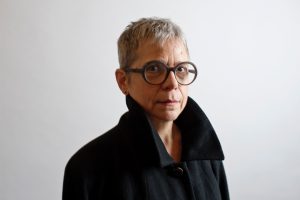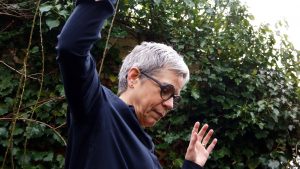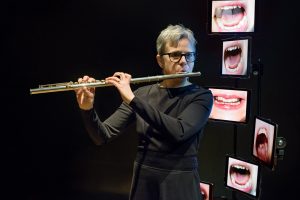by Steve Ricks
Introduction
In 2000 I met composer and flutist Ned McGowan at an SCI National Student Conference in Ann Arbor, MI, a fortuitous experience that has led to a lasting friendship. At the time we met, Ned had recently relocated to Amsterdam to work with, among others, Anne La Berge. My connections with Ned led to my participation in a project he spearheaded called “WRENCH,” which subsequently connected me to several other composers and performers living in Amsterdam, eventually including Anne. Concurrent with all that, my friend and composition colleague at BYU Christian Asplund had met and performed with Anne several times through the improvising scene in Seattle and later in Amsterdam.
In 2017 these connections all came together. In February of that year I hosted Anne and her husband, David Dramm, for a residency and concert at BYU that included her recent multimedia work Utter. Later that year in June, my colleague Christian Asplund and I organized a composition workshop for our students with Anne, David, Ned, and several other Amsterdam-based musicians we had come to know, which was hosted at Anne’s artistic home, Splendor Amsterdam. Those experiences in 2017 and subsequent listening have acquainted me more deeply with Anne’s work, which I find engaging, inspiring, and always with the right amount of “serious fun” (Anne’s words). I hope you enjoy this interview.
– SR
What are your most memorable early musical influences, and which of them seem to have had the most enduring influence?
My parents were both semi-professional musicians. My father was also a research psychologist which evolved into neuropsychology as the field changed. They created the Minnesota Bach Society when we were living in the Twin Cities in my childhood years. My father was a choral conductor and my mother played the violin. In fact, they both just turned 90 and my father has just stopped conducting a community chorus and my mother is still playing the violin. Since birth I was present at rehearsals, concerts and musical gatherings. There was a lot of Bach. The two most enduring influences are the love of practicing from my mother and the deep curiosity that my father has for how the sounds and the emotions of music can deeply touch both performers and audiences.
How integral is Splendor Amsterdam—the venue/collective you co-created—to your work as a composer and performer?
Splendor Amsterdam is a building and a community where I have been able to practice, rehearse, collaborate and perform for the last five years in my own timing and personal style. The high quality sound systems and the comfortable acoustics has inspired many hours of experiment and tweaking.
It has also given me a sense of responsibility and purpose to be part of a diverse community of artists where I can understand my role as a fellow artist both locally and internationally.
I know you’ve been a force in the free improvisation world for years, and have also been an innovator with music technology—how do those two aspects of your work relate to each other? Both historically and at present?
Many professional acoustic improvisers are still shy about engaging with technology whether that is using hardware or software or just cueing sound files on a device. Performers who are at home with technology have often given up playing an acoustic instrument. What a pity that these parallel worlds are taking so much time to share the stage together! Much of my career has been invested in creating works where virtuosic electro acoustic performers can play with creative pleasure and abandon and where music technology nerds can do the same. And they can perform with one another, sharing the same musical space.
One of my biggest projects to provide opportunities for electro acoustic improvisers was when I created and ran the Kraakgeluiden:
“In 1999, together with Steve Heather and Cor Fuhler, [La Berge] founded Kraakgeluiden, a improvisation series based in Amsterdam, exploring combinations of acoustic instruments, electronic instruments and computers, and using real-time interactive performance systems. Many of the musical collaborations that have resulted have taken on a life beyond the Kraakgeluiden series, which ceased in 2006. La Berge’s own music has evolved in parallel, and the flute has become only one element in a sound world that includes samples, synthesis, the use of spoken text and electronic processing.” Bob Gilmore
What are your current favorite electroacoustic music tools—software/hardware/etc.? How has your basic “rig” for live electronic performance changed (or not) through the years?
My first electroacoustic equipment was a microphone. I used it to amplify extended techniques that not only come from the embouchure area of the flute, but other sounds that come from the end or the holes. I also used it to heavily amplify the mouth percussion sounds that have come in so handy when I play with certain groups.
The story I like to tell is that amplifying a flute did not solve the issue of being heard when playing in loud improv settings and I moved on to process the flute as a way to simply be heard. Processing was a way to expand the instrument sonically. I used a Clavia Nord MicroModular and then a Nord Modular rack synth. The Nord was punchy and could be made to sound unconventional which supported the range of extended techniques that I enjoyed processing. I originally used it mostly for processing and rarely as a compositional instrument.
It was a scary time for me when Clavia discontinued the Modular since I had no backup and I was touring the world.
I had been following the development of the Kyma System throughout the 1990’s and into the 21st century but was not aware that it would be for me until they came out with the Pacarana and Paca which would be easy to tour with. The superb audio quality, the generous programming environment and the aesthetic dedication of Symbolic Sound to improvisation and invention has been a major inspiration to me since 2012 when I purchased my first Kyma System.
I use the Kyma System now to process the live flute, create audio and compose. In my solo setup I use Max to administrate control from an iPad and to route information from an Arduino connected to analog and continuous controller pedals.
I am interested in using the computer as a third party, as another personality in the performance. Many of my pieces are in the form of a Max patch or Max app that informs the performers when and when not to play and suggests musical parameters to focus on. The cues that the Max patch gives can be either visual, aural or both. For the visual cues I’ve used videos, lights, DIY LED objects, iPads and smartphones. I was able to purchase 6 iPads as part of the Utter project in 2016 and I use them regularly with ensembles. They run Cycling 74 Mira or Symbolic Sound’s Kyma Control or Javascript, using the p5js library which is controlled using the node.script object in Max. The advantage of using touch sensitive devices is that the communication is two-way between the device and the main computer.
Using your recent work Utter as a springboard, can you talk both specifically and generally about your interest in text and how/why you enjoy exploring text in your work?
Text brings us into a special cognitive, psychological space that is different than when we listen to non-text sounds or music. We create meanings that are deeply personal, and our emotions are touched differently when text and music are combined. That is the core business of singer/songwriters. In my work, I use a semi-narrative form of text that can range from abstract poetry to lists of facts. The text is meant to inspire me to pay attention to my music making in a different way than when I only relate via sound. It is also meant to inspire the audience to listen and receive and interpret the text meanings and musical sounds in their own ways.
Using text is a way to shuffle our musical habits and to scramble listeners’ expectations. Examples are my recent works Assail and Utter. In both of these works I use text to startle people, to jump-start them out of their habits and truly be in the present moment.
Your new album looks great! And its concept is very compelling so I can’t wait to hear it. Can you talk about how it came together?
My husband David Dramm and my daughter Diamanda Dramm and I wanted to document the music that we have been playing together in a form that would be consistent with how we usually perform it. That is, with a serious fun that is particular to us as a family. David and I have been performing as a duo since 1987 and we have been performing onstage in professional settings with Diamanda since she was 11. We’ve played arrangements of numbers from projects that we’ve all been involved with individually and we’ve created arrangements of our arrangements for specific events over the years. This triple LP project has given us the chance to have most of that music in one place.
We describe it as a collector’s item upon release, a musical family history unlike any other. An impossible, rousing mix of punk, country, spoken word and electro.
The 21st century von Trapp family La Berge Dramm.
 photo: Carmen Schabracq
photo: Carmen Schabracq
One final question I had was your perspective on current (or even less current) American electroacoustic music/works/ideas/technologies that seem to have the most resonance in Amsterdam/Europe—and why? Basically, some sort of response that allows for your unique vantage point of your earlier life and training in the US and then your professional life in Europe to the present.
American electro acoustic music is so diverse these days that I cannot draw specific correspondences between such a large country and the small and concentrated scene in Amsterdam. The part of my own roots that I have an intimate connection with is my dedication to the experimentalists including John Cage, Alvin Lucier, Pauline Oliveros and Annea Lockwood. I have also found younger electro acoustic artists such as Katherine Young, Sam Pluta, Lauren Sarah Hayes and Natascha Diels to be sources of inspiration for me. In other words, the pioneers and the mavericks who have developed their own imaginative musical languages remind me of my earlier training and give me food for thought regarding my work here on the other side of the ocean.
Another thought on my US past and my European present is that I left the states after establishing the beginnings of an artistic career. The usual options for young US artists at that time was to pursue an academic career following a PhD. Since I carved a different path by migrating to The Netherlands and financing my work through Dutch grants, fellowships and gigs, I have shared my work with people from walks of life inside and outside various teaching environments. I held a salaried conservatory job for a short time in the 1990’s and for the most part have been freelance. These opportunities to experience a diversity of people and places is a major influence in my vision of humanity and my work. Conversations with myself often touch on: Who are we here in this space right now? What are we doing here and why are we doing it?
URLs of interviews and performances:
https://news.symbolicsound.com/2014/09/portrait-of-anne-la-berge/
http://earreader.nl/archives/14
http://www.paristransatlantic.com/magazine/interviews/laberge.html
Vear, Craig: The Digital Score, Musicianship, Creativity and Innovation; Routledge, 2019.
Interview Portrait by IMA: https://ima.or.at/en/imafiction/video-portrait-07-anne-la-berge/
The Hidden Alliances Exhibition at Ars Electronica: https://annelaberge.com/ars-electronica-2018/
Maze Festivals where my works have been premiered and played by MAZE, the ensemble that I am a member of:
https://www.maze.nu/maze-festival/
Interview on Mexican TV regarding composition and feminisim: https://www.youtube.com/watch?v=ki33YgR4ZDg
Interview regarding works and review of my performance at the first Heroines of Sound Festival in Berlin:
https://missy-magazine.de/blog/2015/07/14/verfremdete-floete-vertraute-geschichten/
Review of IMA Portrait interview and feature on Anne La Berge in Freistil Magazine, Vienna
https://annelaberge.com/freistil/
Performance of RAW for improvising ensemble by MAZE at the Bologna Angelica Festival including the review:
https://annelaberge.com/bologna/
Performance and review of Swamp for improvising ensemble, small speakers and 8m film projector and review at the Wien Modern Festival:
https://annelaberge.com/wien-modern/


